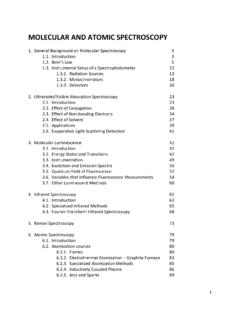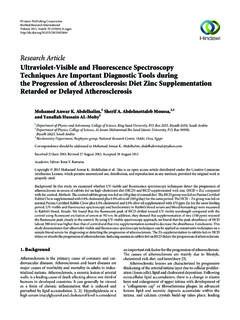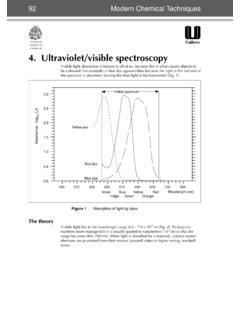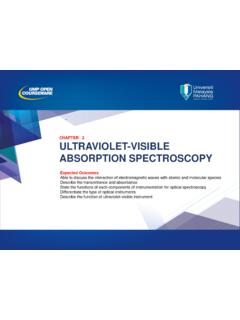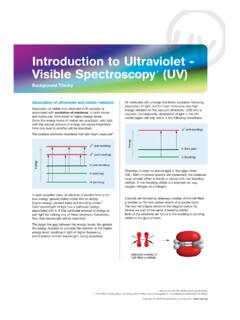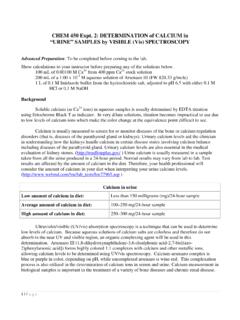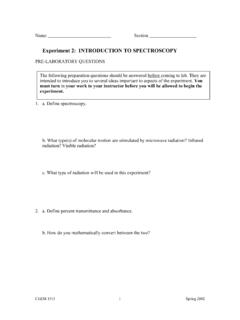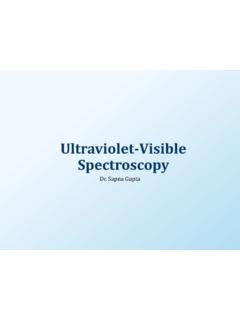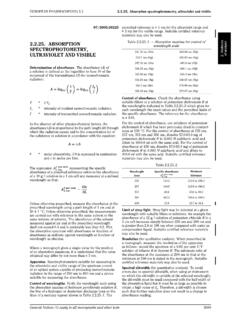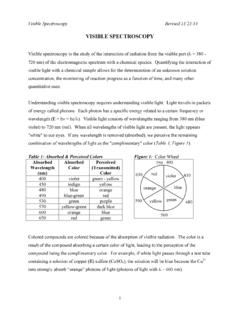Transcription of Ultra-violet Visible Spectroscopy - Yale University
1 Ultra-violet Visible Spectroscopyby Alain MartelliI. Theoretical principlesA. IntroductionMany molecules absorb ultraviolet (UV) or Visible light. The absorbance of asolution increases as attenuation of the beam increases. Absorbance is directlyproportional to the path length, b, and the concentration, c, of the absorbing species,according to the Beer-Lambert Law (see below):A = bcwhere is a constant of proportionality called the molar absorptivity. Differentmolecules absorb radiation of different wavelengths. An absorption spectrum will show anumber of absorption bands corresponding to structural groups within the Electronic transitionsThe absorption of UV or Visible radiation corresponds to the excitation of outerelectrons.
2 There are three types of electronic transitions to be considered: Transitions involving p, s and n electrons. Transitions involving charge-transfer electrons Transitions involving d and f electronsWhen an atom or molecule absorbs energy, electrons are promoted from theirground state to an excited state. In a molecule, the atoms can rotate and vibrate withrespect to each other. These vibrations and rotations also have discrete energy levels,which can be considered as being packed on top of each electronic of UV and Visible radiation in organic molecules is restricted tocertain functional groups (chromophores) that contain valence electrons of low excitationenergy.
3 The spectrum of a molecule containing these chromophores is complex, becausethe superposition of rotational and vibrational transitions with the electronic transitionsgives a jumble of overlapping lines that appears as a continuous absorption Charge-transfer absorptionMany inorganic species show charge-transfer absorption; these are called charge-transfer complexes. For a complex to demonstrate charge-transfer behavior, one of itselectrons must be able to be donated, and another component must be able to accept theelectron. Absorption of radiation then involves the transfer of an electron from the donorto an orbital associated with the acceptor.
4 Molar absorptivities from charge-transferabsorption are large (greater than 10,000 ). Depending on the complex,charge-transfer complexes can absorb almost anywhere in the UV-Vis Possible electronic transitions of p, s, and n electronss s* transitions:An electron in a bonding s orbital can be excited to the corresponding antibondingorbital, though the energy required for this is large. For example, methane (which hasonly C-H bonds, and can only undergo s s* transitions) cannot be seen in typical UV-Vis spectra (200 700 nm).n s* transitions:Saturated compounds containingatoms with lone pairs (non-bondingelectrons) are capable of n s*transitions.
5 These transitions usually needless energy than s s* transitions. Theycan initiated by light whose wavelength isin the range 150 250 nm. The number oforganic functional groups with n s*peaks in the UV region is p* and p p* transitions:Most absorption Spectroscopy of organic compounds is based on transitions of nor p electrons to the p* excited state. This is because the absorption peaks for thesetransitions fall in an experimentally convenient region of the spectrum (200 700 nm).These transitions need an unsaturated group in the molecule to provide the p absorptivities from n p* transitions are relatively low, and range from 10to 100 p p* transitions normally give molar absorptivities between 1,000and 10,000 solvent in which the absorbing species is dissolved also has an effect on thespectrum.
6 Peaks resulting from n p* transitions are shifted to shorter wavelengths(blue shift) with increasing solvent polarity. This arises from increased solvation of thelone pair, which lowers the energy of the n orbital. Often (but not always), the reverse(red shift) is seen for p p* transitions. This is caused by attractive dipole forcesbetween the solvent and the absorber, which lower the energy levels of both the excitedand unexcited states. This effect is greater for the excited state, and so the energydifference between the excited and unexcited states is slightly reduced.
7 This results in asmall red shift. This effect also influences n p* transitions, but is overshadowed by theblue shift resulting from solvation of lone The Beer-Lambert LawThe diagram below shows a beam of monochromatic radiation of radiant powerP0 directed at a sample solution. Absorption takes place and the beam of radiation leavingthe sample has a radiant power P. The amount of radiation absorbed may be measured ina number of ways:P0Pb Transmittance, T = P/P0 %Transmittance, %T = 100 T Absorbance:A = log10 (P0 / P) = log10 (1 / T) = log10 (100 / %T) = 2 log10 %TThe relationship between absorbance and transmittance is illustrated in thefollowing diagram:So if all incoming radiation is absorbed, then percent of transmittance is zero andabsorption is Beer-Lambert Law is:A = bcWhere A is absorbance (unitless), is the molar absorptivity with units of L.
8 ,b is the path length (in cm) of the sample (that is, the length of the cuvette), and c is theconcentration of the compound in solution, expressed in mol. reason why we prefer to express the law with this equation is so thatabsorbance is directly proportional to the other parameters. This way, as long as the lawis obeyed, we can easily determine the concentration or the molar absorptivity of asubstance by measuring its absorbance at a particular wavelength. Note that at highconcentration the Beer-Lambert Law is not obeyed. It can be considered true only forabsorbances between 0 and , though if you want to be really precise, quantify based onabsorbances between and molar absorptivity is a constant for a particular substance at a particularwavelength.
9 So, if the concentration of the solution is halved, so is the ultraviolet - Visible Spectroscopy in molecular biologyA. UV for quantification of nucleic acid concentrationThe concentration of DNA, RNA, oligonucleotides, or even mononucleotides canbe measured directly in aqueous solutions. Aqueous buffers with low ion concentrations( TE buffer) are ideal. The concentration is determined by measuring absorbance at260 nm (subtracting the "blank" absorbance) and then simply calculating concentrationvia a standard factor as per the Beer-Lambert absorption of is equivalent to approximately.
10 50 g/mL double-stranded DNA (dsDNA)33 g/mL single-stranded DNA (ssDNA)40 g/mL single-stranded RNA30 g/mL for ssDNA more precise calculation methods, see the separate section on DNA technicalinformation or use the biopolymer calculator on our purity of a nucleic acid sample can be assessed by calculating the ratiobetween absorbances at 260 nm and 280 nm. This ratio (A260/A280) is used to estimatepurity because proteins absorb more strongly at 280 nm. Pure DNA should have a ratio ofapproximately , whereas pure RNA should give a value of approximately at 230 nm reflects contamination of the sample by substances such ascarbohydrates, peptides, phenols or aromatic compounds.
